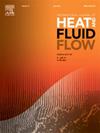Stability and receptivity analyses of the heated flat-plate boundary layer with variable viscosity
IF 2.6
3区 工程技术
Q2 ENGINEERING, MECHANICAL
International Journal of Heat and Fluid Flow
Pub Date : 2024-11-06
DOI:10.1016/j.ijheatfluidflow.2024.109624
引用次数: 0
Abstract
This article presents the modal, non-modal, and resolvent analyses of the boundary layer developed over a heated flat-plate with temperature-dependent viscosity using linear stability theory. The governing equations are derived in the normal velocity–vorticity form by imposing small infinitesimal disturbances on the base flow with the Oberbeck-Boussinesq (OB) approximation. The spectral method is employed to discretize the governing stability equations in the wall-normal direction. The base flow comes from the similarity solution using R-K4th order method along with shooting techniques. The effects of viscosity stratification, inertia, shearing, and buoyancy on the stability of the boundary layer are investigated by varying the sensitivity parameter , Reynolds , Prandtl , and Richardson numbers . The modal analysis shows the time-asymptotic behavior of the disturbances and onset of instability is mainly caused by amplification of Tollmien–Schlichting (T-S) waves similar to as observe in the traditional Blasius case. The modal stability increases with increase in sensitivity parameter and stabilizing effects become more pronounced for liquid than gas. However, the thermal effects lead to destabilize the flow and strong destabilizing effects produced for higher Prandtl number. On the other hand, non-modal analysis displays an early transient growth of disturbances and an existence of these non-normality effects identified from the pseudospectra via. resolvent analysis. The non-modal growth increases with increase in even though T-S modes shift towards the damped region, which indicates the continuous modes in the eigenspectrum are more dominated than the discrete T-S modes due to the thermal effects. To clarify this qualitative change, a component-wise input–output analysis is performed to measure the receptivity to particular external disturbances. The results show the thermal energy of the disturbances is converted into kinetic energy due to thermal effects, resulting in strong receptivity amplification at the continuous mode due to the non-normality of the linear operator. Thus, the boundary layer under the influence of viscosity stratification, heating, and shearing effects is vulnerable to free-stream disturbances that could significantly affect bypass transition
粘性可变的加热平板边界层的稳定性和接受性分析
本文利用线性稳定性理论对加热平板上形成的边界层进行了模态、非模态和解析分析,该平板的粘度与温度有关。通过采用奥伯贝克-布辛斯基(OB)近似法对基流施加小的无穷小扰动,以法线速度-涡度形式导出了控制方程。采用频谱法对壁面法线方向的稳定方程进行离散化。基流来自使用 R-K4 阶方法和射击技术的相似解。通过改变灵敏度参数(ϵ)、雷诺数(Re)、普朗特数(Pr)和理查德森数(Ri),研究了粘度分层、惯性、剪切和浮力对边界层稳定性的影响。模态分析表明,扰动的时间渐近行为和不稳定性的发生主要是由 Tollmien-Schlichting (T-S) 波的放大引起的,这与在传统的 Blasius 案例中观察到的情况类似。模态稳定性随着灵敏度参数的增加而增加,对液体的稳定效应比对气体的更明显。然而,热效应会导致流动失稳,普朗特数越高,失稳效应越强。另一方面,非模态分析显示了扰动的早期瞬态增长,并通过解析分析从伪谱中确定了这些非正态性效应的存在。非模态增长随着ϵ 的增大而增加,即使 T-S 模态向阻尼区转移,这表明由于热效应,等效谱中的连续模态比离散 T-S 模态更占优势。为了澄清这一质变,我们进行了分量输入输出分析,以测量对特定外部干扰的接受能力。结果表明,由于热效应,扰动的热能被转化为动能,从而导致连续模式下由于线性算子的非正态性而产生强烈的接受性放大。因此,在粘度分层、加热和剪切效应的影响下,边界层很容易受到自由流扰动的影响,这些扰动可能会显著影响旁路转换。
本文章由计算机程序翻译,如有差异,请以英文原文为准。
求助全文
约1分钟内获得全文
求助全文
来源期刊

International Journal of Heat and Fluid Flow
工程技术-工程:机械
CiteScore
5.00
自引率
7.70%
发文量
131
审稿时长
33 days
期刊介绍:
The International Journal of Heat and Fluid Flow welcomes high-quality original contributions on experimental, computational, and physical aspects of convective heat transfer and fluid dynamics relevant to engineering or the environment, including multiphase and microscale flows.
Papers reporting the application of these disciplines to design and development, with emphasis on new technological fields, are also welcomed. Some of these new fields include microscale electronic and mechanical systems; medical and biological systems; and thermal and flow control in both the internal and external environment.
 求助内容:
求助内容: 应助结果提醒方式:
应助结果提醒方式:


